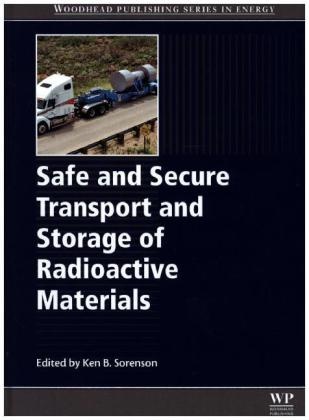Mehr lesen
Informationen zum Autor Ken Sorenson is the Department Manager of Advanced Nuclear Fuel Cycle Technologies at Sandia National Laboratories Safe and Secure Transport and Storage of Radioactive Materials reviews best practice and emerging techniques in this area. The transport of radioactive materials is an essential operation in the nuclear industry, without which the generation of nuclear power would not be possible. Radioactive materials also often need to be stored pending use, treatment, or disposal. Given the nature of radioactive materials, it is paramount that transport and storage methods are both safe and secure. A vital guide for managers and general managers in the nuclear power and transport industries, this book covers topics including package design, safety, security, mechanical performance, radiation protection and shielding, thermal performance, uranium ore, fresh fuel, uranium hexafluoride, MOX, plutonium, and more.
Inhaltsverzeichnis
- Related titles
- List of contributors
- 1. Introduction to the packaging, transport and storage of radioactive materials
- 1.1. Introduction
- 1.2. Overview of the topic
- 1.3. Scope of book
- Part One. Frameworks for operational safety
- 2. Functional requirements for the design of transport packages
- 2.1. Introduction
- 2.2. Future trends in the nuclear industry
- 2.3. General design features to meet regulatory requirements
- 2.4. Packaging requirements
- 2.5. Package design
- 3. Training in the nuclear transport industry
- 3.1. Legal requirements
- 3.2. Training scope (as required by the regulations)
- 3.3. Training required
- 3.4. Refresher training
- 3.5. Other training considerations
- 3.6. Modal guidance
- 3.7. Sample syllabus
- List of abbreviations
- 4. Public relations for the nuclear transport industry
- 4.1. Introduction
- 4.2. Risk perception
- 4.3. Historical overview
- 4.4. Security concerns
- 4.5. Risk communication
- 4.6. Future trends
- 4.7. Additional information
- 5. Risk assessment approaches for the transport of radioactive material
- 5.1. Introduction
- 5.2. Routine, incident-free transportation
- 5.3. Transport accidents in which the radioactive cargo is not damaged
- 5.4. Transport accidents in which the radioactive cargo is damaged
- 5.5. Transport accidents in which gamma shielding is lost
- 5.6. Uncertainty in transport risk assessment
- 5.7. Summary
- 6. Responding to emergencies associated with the transport of radioactive material
- 6.1. Introduction - emergency response: a necessary contribution to transport safety
- 6.2. Some significant events in radioactive material (RAM) transport - lessons drawn
- 6.3. Existing international requirements and recommendations - future trends
- 6.4. Roles and responsibilities for governmental and private, national and local organizations
- 6.5. Specific instrumentation, equipment and assessment tools needed for response according to transport modes
- 6.6. Other specific issues for transport emergency response organization: international issues
- 6.7. Conclusions
- 6.8. Further information and references
- Part Two. Package design and performance for transport
- 7. Structural performance of packages for radioactive materials
- 7.1. Introduction
- 7.2. Performance requirements
- 7.3. From requirements to package layout
- 7.4. Demonstration of package performance
- 7.5. Conclusions
- 8. Thermal performance of transportation packages for radioactive materials
- 8.1. Introduction
- 8.2. Basics of heat transfer
- 8.3. Regulatory aspects
- 8.4. Heat loads
- 8.5. Thermal design features
- 8.6. Materials
- 8.7. Thermal safety evaluations of the package
- 8.8. Testing and analysis
- 8.9. Summary and trends
- 9. Radiation protection by shielding in packages for radioactive materials
- 9.1. Introduction
- 9.2. Design base and safety function of shielding
- 9.3. Current industrial solutions and overview of shielding materials available
- 9.4. Future trends, new requirements, and severe conditions
- 10. Criticality analysis of packages for radioactive materials
- 10.1. Introduction
- 10.2. Regulatory requirements
- 10.3. Factors influencing criticality safety
- 10.4. Establishing the criteria for criticality safety
- 10.5. Prediction of keff
- 10.6. Criticality safety assessments
- 10.7. Current and future challeng

